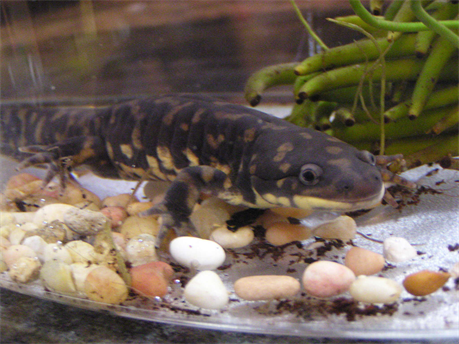
Ambystoma tigrinum
Description
Size 6.5 to 13 inches, robust with irregular yellow to tan blotches. Large broad head with rounded snout. Small eyes, often with gold iris. Largest terrestrial salamander of Ann Arbor.
Natural History
This species is variable in abundance from large populations to rare or uncommon in other areas. They live in woodlands, but can be found in open marshes, grasslands, farmlands and suburbs as well. Their primary requirement is access to permanent and semi-permanent ponds for breeding. Those ponds with no fish in them are preferred. Adult Tiger Salamanders live mostly underground in burrows. They have been found as far as two foot below the surface. It is believed that burrowing allows them to escape temperature extremes on the surface- and may explain their wide habitat tolerances as well as high survivorship. Tiger Salamanders have two major periods of surface activity – late winter/early spring migration to breeding ponds, and a second migration in fall. Many are killed on roadways during those times.
Reproduction and Growth
Males migrate to breeding areas first, followed by females a few days later. Males deposit spermatophores, which the female stores in her cloaca. There is major competition among males for reproduction. After mating, the females lay eggs 24-48 hours later; from 100 to over 1,000 eggs are laid in masses containing 1-100 eggs. Each mass is attached to twigs, grasses, or leaf litter near the bottom of the pond. Depending on water temperatures, hatching occurs in 2-6 weeks or more. Transformation depends on water quality and permanence. In temporary pools, they may transform in 2-3 months, in permanent ponds it may take 4-6 months. Some larvae may over-winter and transform the following year. Some are probably able to breed at this point. This species is potentially long-lived.
Conservation
These relatively large salamanders are undesirable in fish hatcheries because larvae are wrongly accused of feeding on large amounts of small fish. Also larvae are desirable for fishing and they are netted and sold as fish bait in some areas.
Habitat Type
- Ephemeral wetlands.
- Permanent wetlands.
- Forests.
- Grasslands and savannas.
- Agricultural areas.
